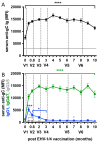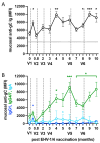Increase in Virus-Specific Mucosal Antibodies in the Upper Respiratory Tract Following Intramuscular Vaccination of Previously Exposed Horses Against Equine Herpesvirus Type-1/4
- PMID: 40266191
- PMCID: PMC11946061
- DOI: 10.3390/vaccines13030290
Increase in Virus-Specific Mucosal Antibodies in the Upper Respiratory Tract Following Intramuscular Vaccination of Previously Exposed Horses Against Equine Herpesvirus Type-1/4
Abstract
Background/objectives: Equine herpesvirus type-1 (EHV-1) enters through the upper respiratory tract (URT) and causes respiratory disease, abortions, and myeloencephalopathy in equids. Pre-existing immunity at the viral entry site, especially mucosal IgG4/7 antibodies, has recently been shown to correlate with protection from disease and incomplete viral replication at the URT. Here, we tested whether intramuscular (i.m.) vaccination with a commercial inactivated EHV-1/4 vaccine can induce mucosal antibodies (mucAbs) at the URT.
Methods: Adult horses with complete EHV-1 vaccination and/or exposure histories were vaccinated i.m. six times within eight months. Before and after each vaccination, blood and nasal swab samples were obtained. Serum and mucAbs were measured in fluorescent bead-based EHV-1 assays.
Results: All horses still had existing EHV-1 specific serum and mucAbs prior to vaccination, which were mainly composed of IgG4/7 antibody isotypes. Serum IgG4/7 significantly increased after the first vaccination and stayed high until the end of the study. An additional short-lasting serum IgG1 response was only induced by the first vaccine application. At the URT, mucAbs increased after five out of six i.m. vaccine injections. Like the systemic antibody response, mucAbs were dominated by IgG4/7 and a small IgG1 increase after the first vaccination.
Conclusions: Our data emphasize that robust EHV-1 specific mucAb levels are obtained after i.m. vaccination with the inactivated EHV-1/4 vaccine used here. The findings have important implications for evaluating EHV-1/4 vaccines for their ability to induce and maintain protective mucosal IgG4/7 antibodies.
Keywords: IgA; IgG1; IgG4/7; antibody; equine herpesvirus; frequent vaccination; inactivated vaccine; mucosal immunity; upper respiratory tract.
Conflict of interest statement
B.W. is the inventor on US patent No. 10/10132 entitled “Enhancing serological assays via fusion proteins”, a technology that is used for the “EHV-1 Risk Evaluation assay” described in this article.
Figures




References
-
- Gilkerson J., Whalley J., Drummer H., Studdert M., Love D. Epidemiological studies of equine herpesvirus 1 (EHV-1) in Thoroughbred foals: A review of studies conducted in the Hunter Valley of New South Wales between 1995 and 1997. Vet.-Microbiol. 1999;68:15–25. doi: 10.1016/S0378-1135(99)00057-7. - DOI - PubMed
Grants and funding
LinkOut - more resources
Full Text Sources
Miscellaneous

